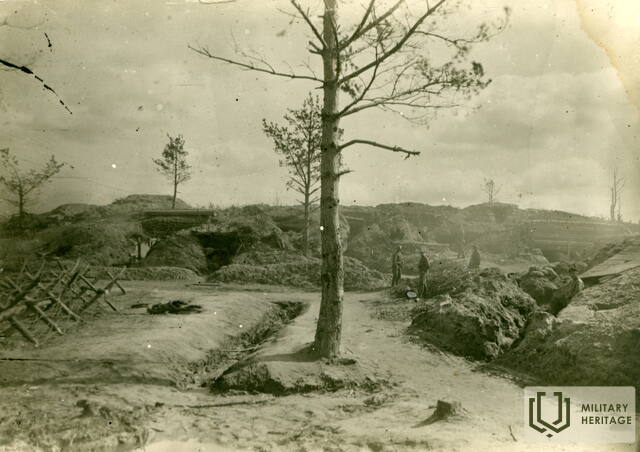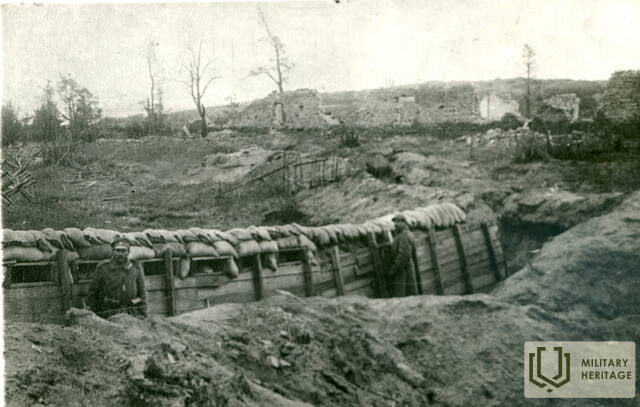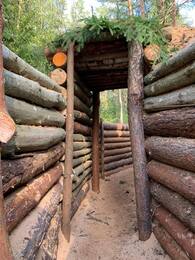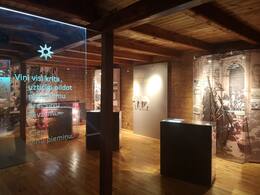The daily routine of Latvian riflemen on Death Island
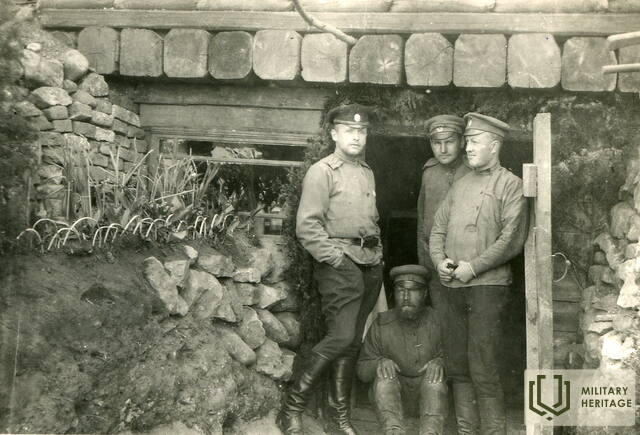
The memoirs vividly describe the daily lives of soldiers on Death Island.
“Life on Death Island was full of hardship and horror. At night, when it got dark and until dawn, war materials and food were delivered to the battle area, the wounded and fallen were taken to the right bank. The collapsed trenches and traffic passages, the damaged telephone lines were urgently repaired. The enemy did not sleep. Mine shells burst over the riflemen's trenches. Machine guns were working. Only a quarter of the island's garrison could close their eyes for a short while. The rest had to be awake. Only at dawn did the night watch change. Food and boiled water were delivered in large containers to the first trenches at 10 a.m. and 6 p.m. Despite the terrible life in the guard posts of Death Island, the riflemen were always in high spirits. They tried in every way to create change and fun in the tiring positional battle. Although the riflemen lived in the rocks of the studs and dug in the ground, the death In the shadows, in the caves and dugouts of their land, even garden flowers and shy country beauties were visible. The dashing Latvian boys - riflemen brought them from the "neutral ground", which was between the riflemen and the German trenches. Of course, it was night work, they were not allowed to appear outside the trenches during the day. And the night time was as if created for all sorts of antics. The clever rifleman turned the cylinder of a German grenade into a flower vase. He loved poetry in books and in life. But that's what a Latvian is - he knows how to find beauty or create it even in the darkest hours of life. Unfading flowers in the riflemen's dugouts and the sound of unfading songs even in the most difficult moments of despair. For the riflemen, war was a sacred task and even the German storm could not silence the joy of their hearts. In the mornings and evenings, when the noise of battle had usually subsided, the riflemen spent these moments of rest chanting folk songs. The Germans responded by singing their war songs. Often, both opponents played mandolins or guitars in the trenches. It seemed that they were no longer enemies, but friendship had been established between the two opponents. Sometimes in the mornings and evenings, the most peaceful relations between us and the opponent existed, but as dusk fell, mutual battles to the death began. Even the quiet, great, peaceful Latvian destiny, the black river Daugava, was not allowed to wave peacefully. Often, high columns of water, conjured by German grenades, rose in it, the splashes of which fell back into the Daugava, disturbing its peace. Hundreds of dead and stunned fish swam downstream. The riflemen tried to use this and tried to catch “concussed” fish downstream of the firing point in the Daugava, and after a good hunt they ate fish soup that the Germans provided for them. The hunt was especially successful when a floating bridge was built on the lower side of the Daugava. In general, as much as the German artillery fire was dangerous and deadly physically and morally during the shelling, when it stopped, it provided pleasant moments for the riflemen. Until the fire subsided during the day, everyone went to the ravines to look for the aluminum and copper heads of German shells. Often, the riflemen rushed in droves to the site of the fallen shell. For what? But those who experienced the riflemen's times will remember that almost all the riflemen who ended up in Riga or with their relatives for a couple of days on vacation had such strange, white rings on their fingers. They were an invention and creation of the riflemen. The aluminum was removed from the projectile heads and melted. The necessary shape was previously cut out of plaster and then poured! The riflemen made various ring shapes: rings with a heart, a very expressive star, some rings had a shard of grenade melted into them, etc. The riflemen loved these rings because they vividly reminded them of everything they had experienced and experienced on the Island of Death. The riflemen cast not only rings, but also made spoons, small figurines and other interesting things from the same material. Mouthpieces began to be made from the copper tubes of hand grenade burners, removing the exploding mercury from them. Of course, accidents also happened and one or two riflemen lost not only their fingers and hands, but also their lives. All unexploded German grenades or shrapnel were gradually dismantled, unloaded and turned into vases, scoopable containers, and most of them were sent home to their relatives as a fond memento from the battlefield. This war was a holy war for the riflemen, and everything connected with the battles became holy and worthy of memory. As lively and confident as the spirit of the riflemen was, because they could not help but believe in their victory, they took just as much care of the care and storage of their weapons of war, which is also of great importance in the life of a soldier. The riflemen's main weapon was the rifle. It was their friend in good and bad days. It was not for nothing that the riflemen called her their "wife" and "bride" in their letters. On the island of Death, one could see the riflemen cleaning their rifles, torching their clothes, shoes, etc. When the rifles were wiped clean, they were placed in specially prepared upright racks right in the trenches, so that they would be at hand at any moment and could be put to work without delay.
http://latviesustrelniekusaraksts.lv/Kaujas_darbiba/Book_2.html (accessed 20.07.2021
Related topics
Related objects
Death Island
The group of islands is located in Daugava on the southern side of the Riga HPP reservoir near Daugmale. The Death Island is one of the scariest and most legendary battlefields of World War I. When the Russian Army withdrew from Kurzeme and Zemgale in 1915 some units remained on the left bank of Daugava, where they took positions to fight the German Army. The banks of the river were connected by a bridge. One of the largest chemical weapons usage cases in the territory of Latvia took place here. Latvian soldiers called the place ‘Death Island’, but soldiers of other nationalities called it ‘Hell’. The position of Death Island was of strategic and symbolic importance. For Latvian soldiers it was part of Kurzeme occupied by Germany. Fights took place on the banks of Daugava near Ikšķile, and in some way they were associated with the fights of the ancestors during the Crusades. Nowadays this location is accessible by boat. Territory of the Riga HPP reservoir that was not flooded can be seen. The monument designed by E. Laube still remains. Defensive position elements have been reconstructed in some places. There is an information stand on the bank of Daugava near the Ikšķile Kābeļu hill. Death Island became a group of islands after the construction of the Riga HPP reservoir was finished.
Cultural Heritage Centre "Tīnūži Manor"
The Cultural Heritage Centre ‘Tīnūži Manor’ is located in Ogre municipality, Tīnūži village, 7 km from the cities of Ogre and Ikšķile. The first written evidence about the manor dates back to the 16th century. Until the mid-18th century it was considered an economic production unit with small and insignificant buildings. But over time it grew into a large farm. During World War I, battles between the Russian and German armies took place here, and the Latvian Riflemen were also involved. During the War of Independence Tīnūži manor was used as the headquarters and armoured car park of the 1st Valmiera Infantry Regiment of the Latvian Army. In 1932, the manor was given to the Union of the Latvian War Invalids, which provided accommodation and care for war veterans. During World War II (in 1943) the German Army unit FAT 212 was transferred from Estonia to Tīnūži manor. It was a saboteur unit that prepared soldiers to fight the Red Army. Latvian soldiers were also trained in the arts of intelligence gathering, guerrilla warfare tactics and sabotage. The lord house of Tīnūži manor was destroyed when the Red Army was moving towards Riga. Nowadays it is a place with a beautiful landscape and historical buildings on the banks of the Little Jugla River. Exhibits dedicated to historical events, including the ones concerning the Latvian Riflemen, can be seen at the Cultural Heritage Centre ‘Tīnūži manor’.





